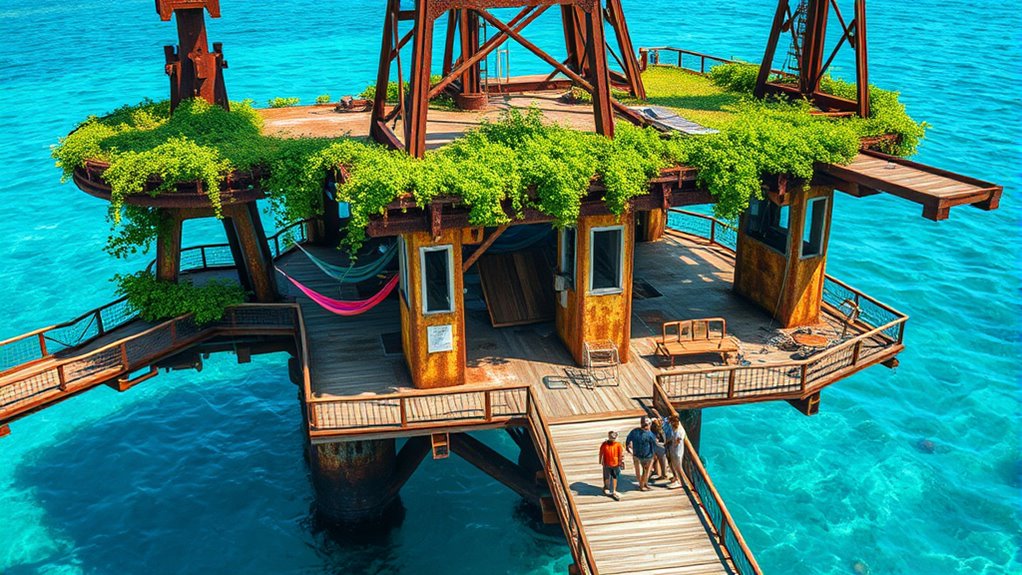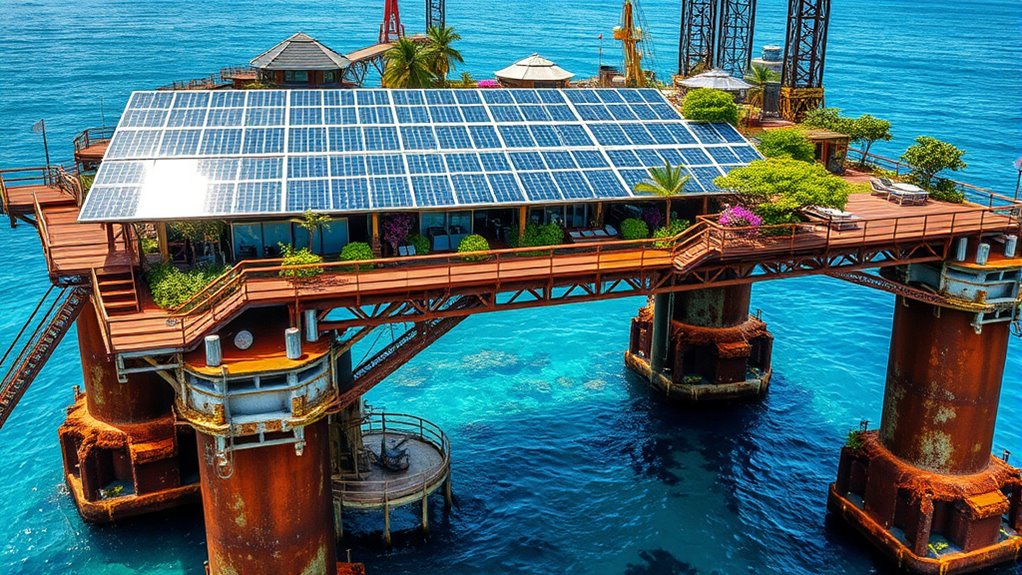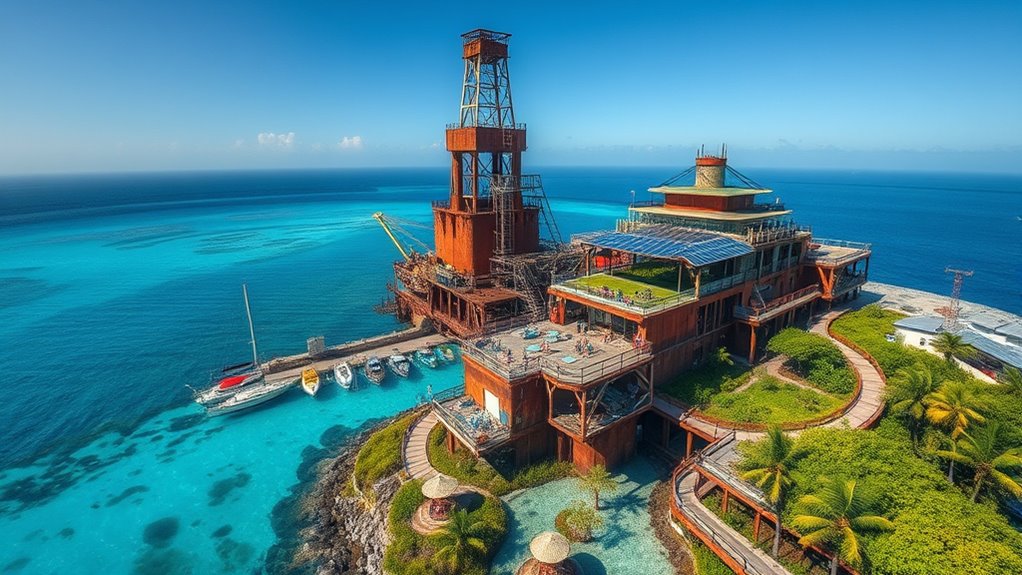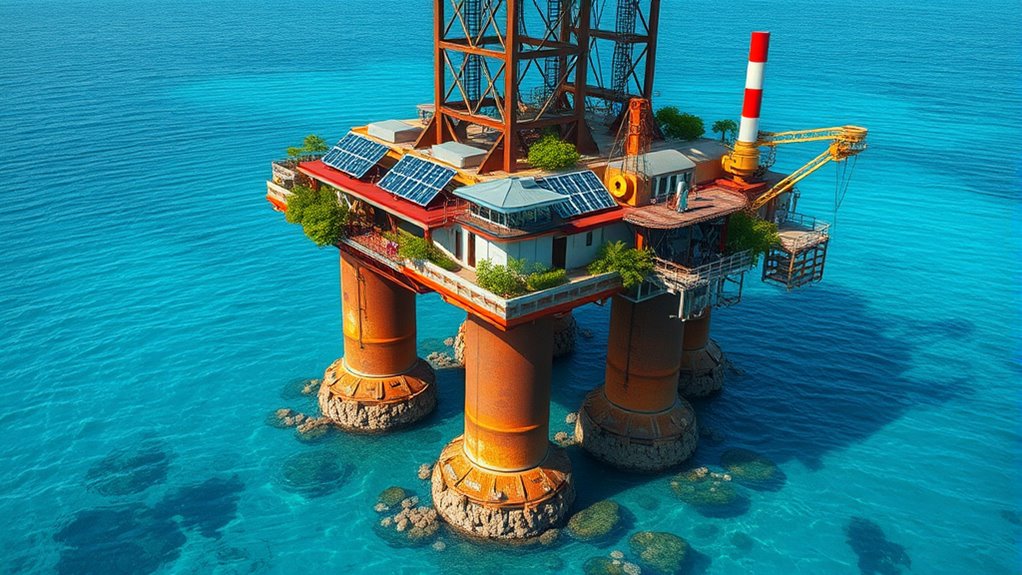Transforming abandoned oil platforms into eco-resorts shows how rigs can become vibrant marine habitats that support biodiversity and boost eco-tourism. Through careful planning, structures are modified and anchored on the seabed, creating habitats for fish, corals, and endangered species. These projects reduce environmental impacts and generate economic benefits for local communities. If you continue exploring, you’ll discover how innovative techniques, international examples, and future prospects are making rigs-to-reefs a sustainable ocean solution.
Key Takeaways
- Abandoned oil platforms are repurposed into eco-resorts, transforming decommissioned structures into sustainable tourism destinations.
- Rig-to-reef projects involve careful structural modification, environmental assessments, and eco-friendly materials to create thriving marine habitats.
- These conversions boost local economies through eco-tourism, diving, and snorkeling, supporting community development and conservation efforts.
- International examples demonstrate successful transformations, highlighting regional adaptations and ecological benefits.
- Future innovations focus on sustainable materials, autonomous deployment, and enhanced ecological education to promote long-term environmental and economic sustainability.
The Transformation From Oil Rig to Eco-Resort

The transformation from oil rig to eco-resort begins with careful planning and technical modifications that repurpose existing structures. You’ll start by evaluating the rig’s design to determine the best conversion method—whether towing and placing it at a new site, toppling it onto the seabed, or removing its top section. Structural reinforcements are essential to ensure safety and durability for future use. You’ll also need to cap wells and secure the platform to prevent environmental hazards. Once the foundation is ready, additional construction transforms the rig into a sustainable, inviting destination. This process requires collaboration with regulatory agencies to obtain permits and adhere to environmental standards. The goal is to convert the old oil infrastructure into a thriving habitat and attraction, blending industry legacy with eco-friendly innovation. Understanding water chemistry and environmental regulations is crucial to ensure the safety and sustainability of the new eco-resort. Incorporating environmental standards and best practices helps minimize ecological impact throughout the conversion process. Embracing a creative approach can facilitate innovative solutions during the transformation, ensuring the project meets both safety and ecological goals. Additionally, assessing drainage systems is vital to prevent water contamination and manage runoff effectively. Considering sustainable materials during renovation can further enhance the eco-friendly aspect of the project.
Environmental Benefits of Repurposing Oil Platforms

Repurposing oil platforms as artificial reefs offers significant environmental benefits by transforming industrial structures into thriving marine habitats. These structures quickly become homes for diverse marine life, supporting fish, corals, and other sea creatures. They help regenerate local ecosystems by providing new breeding and feeding grounds, which boosts biodiversity. As these structures attract marine species, they reduce fishing pressure on natural reefs, helping preserve fragile ecosystems. Additionally, they improve water quality by encouraging natural filtration processes. The creation of artificial reefs also enhances coastal resilience by reducing erosion and buffering storm impacts. Furthermore, these projects can promote marine biodiversity and support local fishing communities by increasing fish stocks. The development of artificial reefs can also stimulate eco-tourism and educational opportunities in coastal regions. Promoting community engagement is essential to ensure these initiatives align with local conservation goals and benefit surrounding communities. Overall, converting decommissioned platforms into reefs promotes healthier oceans, supports marine populations, and contributes to environmental conservation efforts—turning industrial remnants into essential ecological assets. Implementing effective risk management strategies ensures these projects remain sustainable and environmentally beneficial over time.
Technical Processes Behind the Conversion

Converting offshore oil platforms into artificial reefs involves several precise technical methods designed to guarantee safety and environmental compliance. You’ll typically choose from techniques like tow-and-place, where the entire jacket structure is detached and transported to an approved reef site. Alternatively, the topple-and-place method involves detaching the structure and laying it horizontally on the ocean floor. The partial removal approach cuts the top portion of the platform at about 85 feet, then places it on the seabed. Before any reefing, associated wells are capped and abandoned per federal regulations. Throughout these processes, agencies such as BSEE oversee permits, ensuring safe placement and removal. Proper planning and adherence to Environmental standards are essential to successfully transforming these structures into thriving marine habitats. Maintaining compliance with safety protocols minimizes ecological impact during installation and ensures the long-term success of reef growth. Additionally, careful structural assessment is crucial to determine the stability and suitability of the platform for reefing activities.
Economic Advantages for Oil Companies and Local Communities

You can save money on decommissioning costs by converting oil platforms into eco-resorts, turning expenses into assets. These projects also generate revenue through eco-tourism, bringing in visitors and supporting local businesses. Over time, the platform’s new function enhances long-term value for both oil companies and nearby communities. Additionally, utilizing sustainable practices ensures environmental preservation and boosts the project’s appeal to eco-conscious travelers. Incorporating load‑planning tools can help optimize energy use and reduce operational costs, further increasing the project’s efficiency and sustainability. Implementing a holistic SEO approach can also improve visibility and attract more visitors to the eco-resort. Employing raw food principles in the resort’s dining options can promote health-conscious choices and appeal to eco-friendly tourists. Moreover, selecting appropriate projector technology for outdoor or indoor entertainment areas can enhance guest experiences and add value to the resort’s amenities.
Cost Savings From Decommissioning
By transforming decommissioned oil platforms into artificial reefs or eco-resorts, oil companies can substantially cut costs associated with removal and disposal. Instead of paying hefty fees for complete removal, they can repurpose structures, saving millions per project. This approach reduces transportation, labor, and landfill expenses. Additionally, states often share in these savings, easing budget strains. You benefit from avoiding costly decommissioning procedures while supporting marine habitat development. Unique and Wicked Planters options for enhancing the visual appeal of these structures can further increase their value and ecological benefits.
Revenue From Eco-Tourism
Eco-tourism generated from repurposed oil platforms offers significant economic benefits for both oil companies and local communities. As a visitor, you’ll contribute to local economies through spending on tours, diving, and accommodations. These eco-resorts attract diving enthusiasts, marine researchers, and eco-conscious travelers, boosting hospitality and service sectors. Oil companies benefit by transforming costly decommissioning into revenue streams, often sharing profits with local governments. This creates a sustainable income source that supports community projects and infrastructure. Additionally, increased tourism raises awareness about marine conservation efforts, drawing funding and partnerships. Overall, repurposing platforms into eco-resorts creates a win-win situation—driving economic growth, promoting environmental stewardship, and providing ongoing revenue opportunities for local stakeholders.
Long-term Asset Value
Transforming decommissioned oil platforms into eco-resorts not only boosts tourism but also enhances their long-term value as assets. This repurposing creates ongoing economic benefits for oil companies and local communities. By converting structures into thriving ecosystems and tourist attractions, you extend the lifespan of these assets beyond their original purpose. This shift reduces costs associated with removal and disposal, saving millions. Additionally, communities gain new revenue streams from tourism, fishing, and conservation activities. The innovative use of these platforms can also serve as environmental restoration projects, helping to improve marine ecosystems and biodiversity. Proper management of these conversions can also mitigate pest issues that might arise, ensuring the longevity of the eco-resorts. Incorporating sustainable practices can further maximize long-term asset value, which can be amplified through sustainable development strategies to ensure ongoing ecological and economic benefits for all stakeholders involved. Moreover, implementing community engagement initiatives can foster local support and participation in these projects, enhancing their success and sustainability.
International Examples of Rigs-to-Reefs Projects

International efforts to convert oil platforms into reefs showcase diverse approaches and innovative uses. In California, since 1958, old structures like automobiles and streetcars have been repurposed into artificial reefs, attracting marine life and supporting local fisheries. Gulf of Mexico states have transformed nearly 200 platforms into thriving ecosystems, boosting biodiversity and tourism. Malaysia took a unique step by converting a decommissioned platform into a scuba diving resort, blending conservation with recreation. Thailand’s rigs-to-reefs program, developed through international cooperation, emphasizes ecological benefits and sustainable practices. These projects highlight how different regions adapt their strategies based on local conditions, regulatory environments, and ecological goals. Incorporating growing and harvesting chia seeds into sustainable practices can serve as an example of how resourcefulness supports ecological balance. Such global examples demonstrate the versatility and potential of rigs-to-reefs initiatives to support marine ecosystems and local economies worldwide.
Regulatory and Safety Considerations

Regulatory and safety considerations are central to ensuring that rigs-to-reefs projects protect both marine ecosystems and public safety. You must navigate strict federal and state regulations before transforming an oil platform into a reef or resort. Agencies like BSEE and the U.S. Army Corps of Engineers oversee permits, safety protocols, and environmental compliance. You need to ensure that all associated wells are properly capped and abandoned to prevent leaks. Liability for residual oil or potential hazards remains with the operator, who must also fund ongoing maintenance and oversight.
- Obtain necessary permits from federal and state authorities
- Follow safety standards for structure removal and placement
- Conduct environmental assessments to prevent ecological risks
The Ecological Impact on Marine Life and Biodiversity

You’ll notice that transforming oil platforms into reefs creates diverse habitats that attract a wide range of marine species. These structures boost local populations by providing shelter and breeding grounds, often leading to healthier ecosystems. Additionally, they support endangered species by offering safe havens, helping preserve marine biodiversity.
Enhanced Habitat Diversity
When oil platforms are transformed into artificial reefs, they considerably enhance habitat diversity by creating complex structures that support a wide variety of marine species. These structures provide shelter, breeding grounds, and feeding areas that were previously unavailable in the open ocean. As a result, the reef becomes a bustling hub of biological activity, attracting different species and encouraging ecological interactions. You’ll notice that this increased habitat complexity leads to richer ecosystems and more resilient marine communities.
- Diverse habitats support various fish, invertebrates, and coral species
- Structures create microenvironments with different light and flow conditions
- The reef supports both juvenile and adult stages of many marine organisms
Increased Marine Populations
Transforming oil platforms into artificial reefs substantially boosts marine populations by providing abundant habitats that attract and sustain diverse species. As a result, you’ll see increased numbers of fish, crustaceans, and other marine creatures congregating around these structures. The complex surfaces, nooks, and crannies create ideal breeding and shelter zones, encouraging species to settle and reproduce. Over time, these habitats support thriving communities that enhance local biodiversity. This concentration of marine life not only benefits the ecosystem but also improves fishing yields and divers’ experiences. The reef’s stability and protection from predators foster the growth of various populations, leading to a richer, more resilient marine environment. Overall, these artificial reefs play a vital role in revitalizing marine populations and sustaining biodiversity.
Support for Endangered Species
Artificial reefs created from decommissioned oil platforms substantially benefit endangered marine species by providing critical habitats that are often scarce in their natural environments. These structures serve as safe breeding grounds, shelter from predators, and feeding sites, helping vulnerable populations recover and thrive. By enhancing biodiversity, they support the resilience of entire ecosystems.
- They attract and sustain endangered species like sea turtles and certain fish that depend on complex habitats.
- They help restore natural behaviors such as nesting and nursery activities.
- They create refuges that reduce human-related threats, like overfishing and habitat destruction.
These reefs play a essential role in conservation efforts, promoting the survival of endangered marine life and maintaining ecological balance in offshore environments.
Visitors’ Experience and Sustainable Tourism Opportunities

Abandoned oil platforms converted into eco-resorts offer unique and immersive experiences for visitors interested in marine environments. As a guest, you can explore vibrant underwater worlds through guided scuba diving and snorkeling excursions directly from the platform. You’ll witness thriving coral reefs, diverse sea life, and colorful fish thriving on the structures. The resort’s design emphasizes sustainability, encouraging eco-friendly practices like waste reduction and energy conservation, ensuring minimal impact on the surrounding ecosystem. Educational programs and interpretive tours reveal the platform’s transformation and marine conservation efforts. Opportunities for sustainable tourism include birdwatching, kayaking, and participating in reef restoration projects. This experience not only enriches your understanding of marine ecosystems but also supports local economies and promotes awareness of ocean conservation.
Future Prospects and Innovations in Rigs-to-Reefs Initiatives

Looking ahead, innovations in rigs-to-reefs initiatives promise to enhance both environmental and economic outcomes. You can expect new technologies to improve reef placement accuracy, reduce environmental impact, and extend the lifespan of artificial habitats. Future projects may incorporate eco-friendly materials that support marine growth while minimizing pollution. Additionally, advanced monitoring systems will allow real-time tracking of reef health, helping managers make data-driven decisions.
- Deployment techniques using autonomous underwater vehicles for precise placement
- Development of biodegradable reef materials that promote natural ecosystems
- Integration of renewable energy sources to power monitoring and maintenance systems
These innovations will boost conservation efforts, attract more tourism, and optimize costs, making rigs-to-reefs programs more sustainable and impactful for decades to come.
Frequently Asked Questions
How Long Does the Entire Rig-To-Reef Transformation Process Typically Take?
The entire rig-to-reef transformation usually takes several months to over a year, depending on the project’s complexity. You’ll need to go through planning, permitting, and preparation stages, which involve environmental assessments, safety checks, and approvals from agencies like BSEE and the U.S. Army Corps of Engineers. Once permits are secured, the actual conversion, whether tow-and-place or topple-and-place, can be completed in a few weeks to months.
What Environmental Regulations Must Be Adhered to During the Conversion?
During a rig-to-reef conversion, you must adhere to strict environmental regulations. You’ll need permits from the Bureau of Safety and Environmental Enforcement (BSEE) and the U.S. Army Corps of Engineers. You’re required to cap and abandon wells properly, prevent oil leaks, and guarantee the structure’s placement minimizes environmental impact. These regulations protect marine ecosystems, support biodiversity, and ensure safe, environmentally responsible transformation of offshore platforms into reefs or eco-resorts.
Are There Any Risks of Oil Leaks or Residual Pollution From Repurposed Rigs?
A bird in the hand is worth two in the bush, so you should know that residual pollution or oil leaks can still occur from repurposed rigs. Although regulations mandate capping wells and removing residual oil, there’s always some risk of seepage or leaks over time. Proper maintenance, monitoring, and strict compliance help minimize these risks, but they can never be entirely eliminated, so ongoing vigilance remains essential.
How Do Local Communities Benefit Economically From Eco-Resort Conversions?
You benefit economically from eco-resort conversions through increased tourism, which boosts local businesses like hotels, restaurants, and dive shops. These projects create jobs during construction and operation, providing steady income for residents. Additionally, they attract visitors year-round, helping diversify your local economy and reduce reliance on traditional industries. The increased activity also raises tax revenue, supporting community services and infrastructure improvements for your area.
What Are the Long-Term Maintenance Requirements for These Artificial Reefs?
You need to understand that long-term maintenance for artificial reefs involves ongoing monitoring of marine health and structural integrity. You’ll be responsible for inspecting the structures periodically, managing marine growth, and addressing any corrosion or damage. Regular coordination with environmental agencies guarantees compliance with regulations, while repairs or upgrades are needed to sustain habitats and safety. Staying proactive helps preserve the reef’s ecological and economic benefits over the years.
Conclusion
Transforming oil rigs into eco-resorts proves you can turn environmental challenges into opportunities. Did you know that over 2,000 rigs worldwide have been repurposed, providing habitats for countless marine species? By embracing these innovations, you help support biodiversity, boost local economies, and promote sustainable tourism. The future of rigs-to-reefs projects is bright, offering you a chance to enjoy unique underwater experiences while protecting our oceans—proving that even abandoned structures can become thriving eco-friendly destinations.







